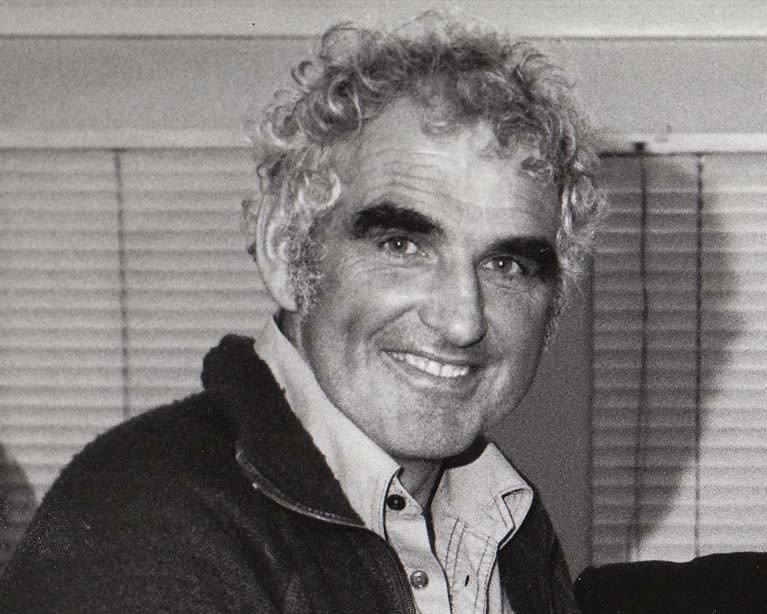Displaying items by tag: Roy Dickson
Roy Dickson 1932-2020: He Was a Sailing Universe
The death of Roy Dickson of Sutton and Howth at the age of 87 takes from among us one of the most multi-talented people in sailing, a man whose 75-year career of innovation and success afloat had started as a teenager with an International Snipe class dinghy at the now-defunct Kilbarrack SC on the sheltered waters inside Dublin Bay’s Bull Island in the 1940s. It was a sailing life well-lived which only concluded in his mid-80s with a little Corby 25, the last Rosie, which he’d modified himself to accommodate the infirmities of old age so that he could continue to pursue a sport which was his life-long passion.
In recent years he will have been thought of the doyen of boat building and modification through the use of modern materials. But as a celebratory lunch organised for him by his many shipmates past and present, inshore and offshore, in Howth Yacht Club in 2015 reminded us, in his astonishingly long career he did his duty and more by wood before bringing in various modern and more exotic materials.
 Roy Dickson’s first boat in the late 1940s was an American-designed Snipe, which he raced from Kilbarrack SC
Roy Dickson’s first boat in the late 1940s was an American-designed Snipe, which he raced from Kilbarrack SC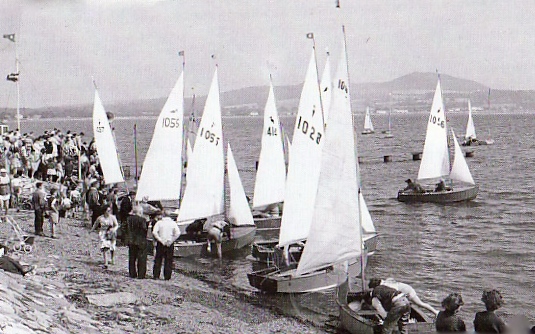 Although its “premises” were crowded into a limited space between road and shore, the now-defunct Kilbarrack SC on the north shore of Dublin Bay was an ideal sailing nursery on the tidal but sheltered waters inside the Bull Island. It is seen here in its glory days as a stronghold of the Heron class. Photo: W N Stokes
Although its “premises” were crowded into a limited space between road and shore, the now-defunct Kilbarrack SC on the north shore of Dublin Bay was an ideal sailing nursery on the tidal but sheltered waters inside the Bull Island. It is seen here in its glory days as a stronghold of the Heron class. Photo: W N Stokes
In fact, Roy Dickson was in his prime in exactly the right era, when the Do-It-Yourself boatbuilding movement was at its peak. But among DIY types, he was very quickly into a league of his own, moving almost immediately to a standard which surpassed that of many professionals, so much so that as his interests in sailing broadened to include complex offshore racers, the design and build professionals treated him as one of their own, while on the water other sailors regarded him as the tops.
Yet he managed all this while running the family business in motor parts (which added an engineering outlook to his many skills), and raising a family in Sutton in a lifestyle which reflected the close presence of the sea, which was at its most sheltered along the shore at Kilbarrack. Those early ventures afloat with a Snipe called Bambi at Kilbarrack began before the little club’s sailing waters inside the Bull Island were divided and made prone to silting by the construction of the fixed causeway across to the middle of the island.
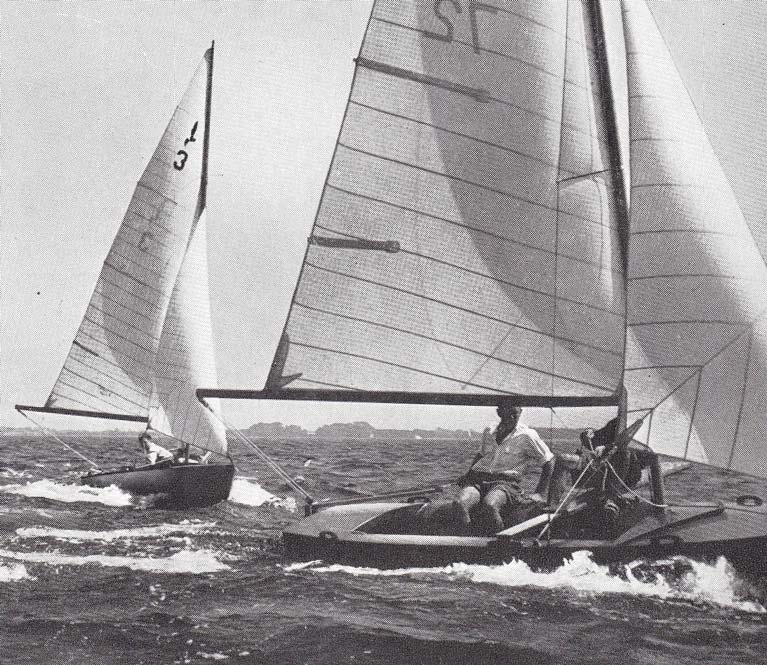 Roy Dickson built and raced two Jack Holt-designed Hornets, complete with sliding seats in the style of the International Canoe Class
Roy Dickson built and raced two Jack Holt-designed Hornets, complete with sliding seats in the style of the International Canoe Class
Until that happened, KSC had a wonderful sheltered sailing area towards high water, when they'd a huge saltwater lake all the way to the Wooden Bridge. Thus they could get sailing even when conditions in Dublin Bay ruled out sailing at Sutton Dinghy Club itself. But soon enough, the young Roy Dickson had himself moved to Sutton, where he was Commodore in 1954 at the age of 22 and already winning international events, and he'd changed boats. He built himself two Jack Holt-designed 16ft Yachting World Hornets – complete with International Canoe-style sliding seats for the crew - between 1954 and 1959, and racing them with success.
But as the best racing in Sutton was in the IDRA 14s, he built himself one of them – Kon Tiki - in 1960, and then in 1961 he and Bunny Conn were in the forefront of the introduction of the Enterprise class, so that was his next command.
 Sutton Dinghy Club – Roy Dickson was Commodore here in 1954 at the age of 22.
Sutton Dinghy Club – Roy Dickson was Commodore here in 1954 at the age of 22.
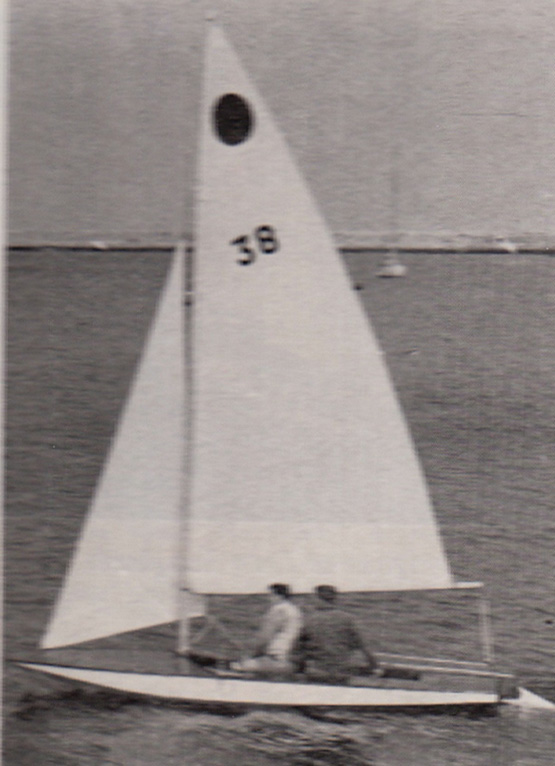 The debut: Roy Dickson sails his new Fireball – the first in all Ireland – across to Dun Laoghaire from Sutton in September 1962
The debut: Roy Dickson sails his new Fireball – the first in all Ireland – across to Dun Laoghaire from Sutton in September 1962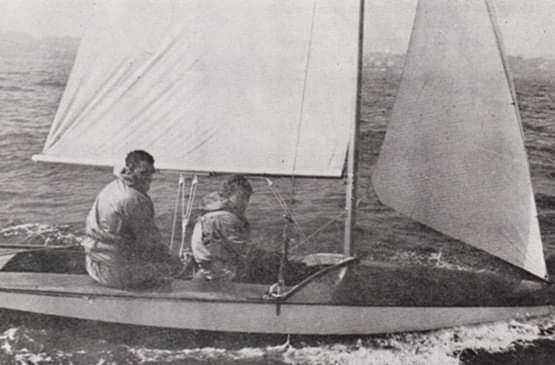 Roy Dickson and fellow Sutton sailor David Lovegrove in a Fireball
Roy Dickson and fellow Sutton sailor David Lovegrove in a Fireball
However, it wasn't until 1962 that all the Dickson stars came into alignment – the International Fireball appeared. He was in there from the start – his first Fireball was No 38 – and with the class's flexible measurement system, the Dickson imperative for innovation had free range. And what he did was noticed by others. It's said that in his dozen or so years with the Fireballs, if some modification he made to his boat of the day proved beneficial, it would be done on every boat in Ireland within a week, and on every competitive boat in the world within a month. And in spreading the news, Roy was always generous with his expertise and assistance.
Former Irish sailing President David Lovegrove – regularly both a crewman or a competitors - particularly remembers how Roy’s home workshop was always open to anyone who shared his level of enthusiasm, and the man himself would willingly work late into the night to ensure that some item of broken gear – whether it was his own or an opponent’s – was ready for the next day’s racing.
As for Roy's sailing, he was competitive right up to world level, doing an early Fireball worlds in America with success with a youthful David Lovegrove on the wire, with another Worlds in the Lebanon – God be with the days when you'd think of having a world sailing championship there – seeing one Bob Fisher as Roy's wireman.
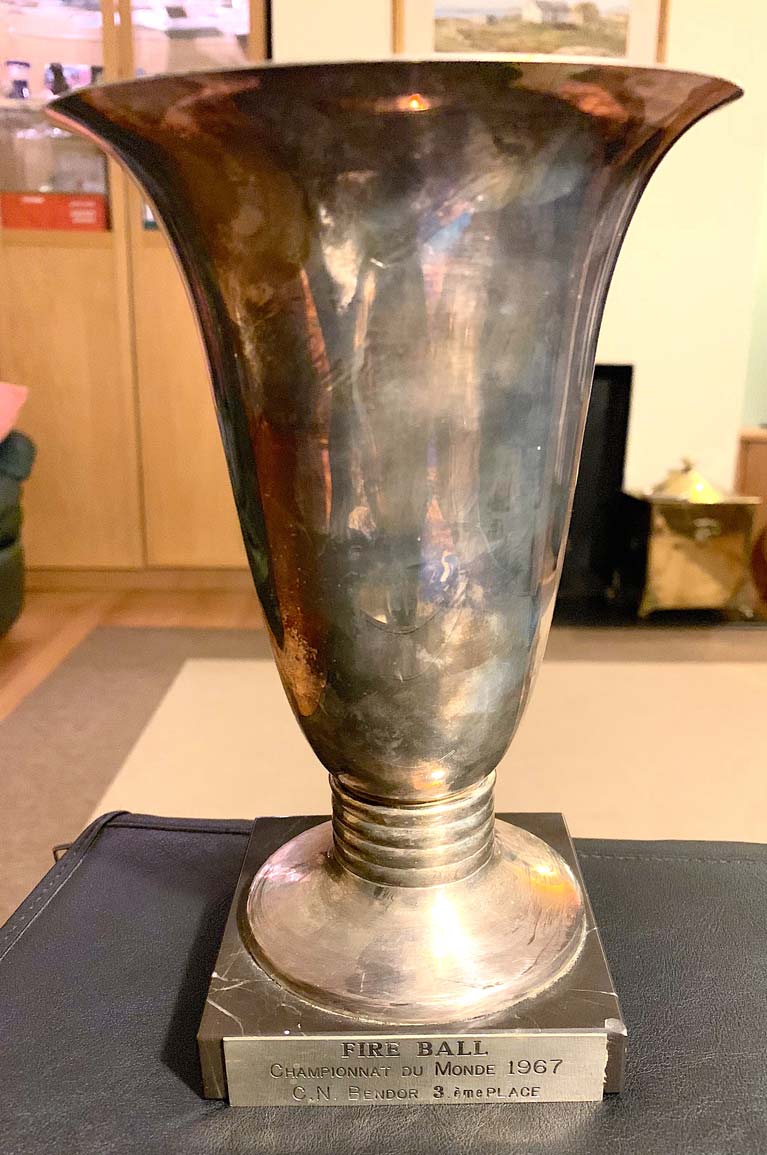 Roy Dickson has won many sailing trophies at home and abroad, and one which has survived down the years is for third in the Fireball Worlds 1967. Photo: Brian Turvey
Roy Dickson has won many sailing trophies at home and abroad, and one which has survived down the years is for third in the Fireball Worlds 1967. Photo: Brian Turvey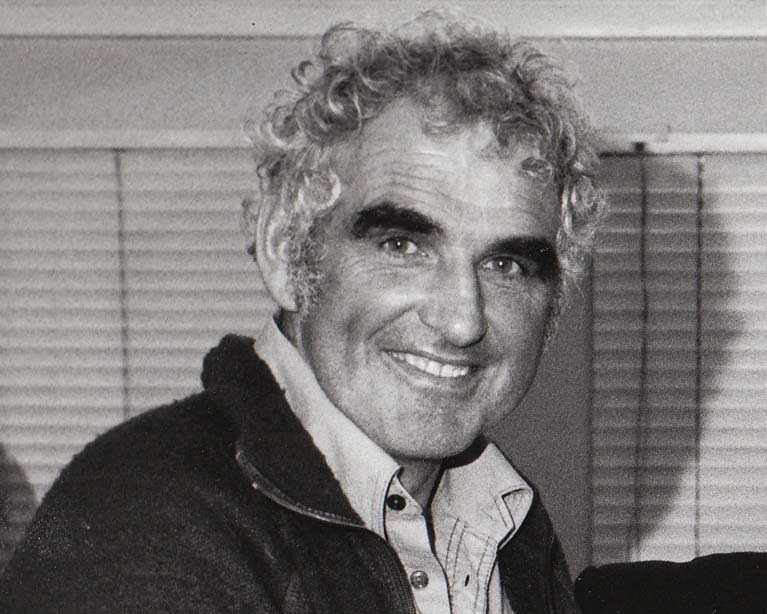 Roy Dickson at the National Yacht Club in 1984, winner of the Irish Half Ton Championship.
Roy Dickson at the National Yacht Club in 1984, winner of the Irish Half Ton Championship.
Eventually, the Dickson campaigning moved into offshore racing and a Howth base (he had joined HYC in 1974), with a succession of boats which, when combined with the possibilities provided by a variety of measurement rules, provided the artist with an enormous canvas to work with, and he was busy for decades.
He started offshore with an S&S 30, but then bought a new Beneteau First Half Tonner as one of a group purchase with other HYC members in 1980. After the first year, Roy’s boat became different, as he fitted a fractional rig and extended the stern with a sugar scoop, moving steadily to the top of the performance table and winning the Irish Half Ton Championship at the National YC in 1984.
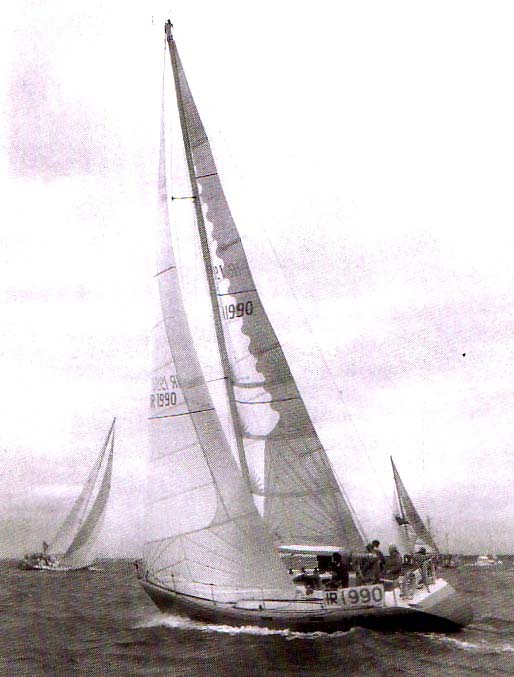 Roy Dickson’s newly-acquired Holland 39ft Imp at the start of the 1987 Fastnet Race, in which he won the Philip Whitehead Cup. He was racing with experimental sails, but soon moved to establish a close relationship with McWilliam Sailmakers.
Roy Dickson’s newly-acquired Holland 39ft Imp at the start of the 1987 Fastnet Race, in which he won the Philip Whitehead Cup. He was racing with experimental sails, but soon moved to establish a close relationship with McWilliam Sailmakers. Top talent – Roy Dickson in the early days on Imp with Peter Wilson, one of many front-line sailors who were keen to sail on the Dickson boats.
Top talent – Roy Dickson in the early days on Imp with Peter Wilson, one of many front-line sailors who were keen to sail on the Dickson boats.
Having exhausted all the possibilities of Half Tonner modification, he then took on the legendary Ron Holland 39-footer Imp, and with her he won the Philip Whitehead Cup in the 1987 Fastnet Race. His sailing enthusiasm was if anything greater than ever, but by his mid-50s he was increasingly troubled by arthritis, particularly of the knees. Yet he gave himself another three decades of active sailing by fitting his boats with wheel steering (his own design and installation, of course) which – as he drily observed – was for him an improvement on a tiller, in that it gave him much more room to move around the aft end of the cockpit, and was also something very useful to hang onto in extreme conditions.
Imp was the first of his boats to get this modification, and there were other interim craft, but his years of maturity became the Dickson-Corby era. He had become intrigued by the highly individual designs of John Corby of Cowes, and in due course he completed the Corby 40 Cracklin Rosie. Her hull had been built in Cowes by Mark Downer, who so enjoyed the Dickson approach that he crewed with him on Cracklin’ Rosie in major events – when success was frequent - whenever possible.
 The Corby 40 Cracklin’ Rosie, probably Roy Dickson’s most famous boat.
The Corby 40 Cracklin’ Rosie, probably Roy Dickson’s most famous boat.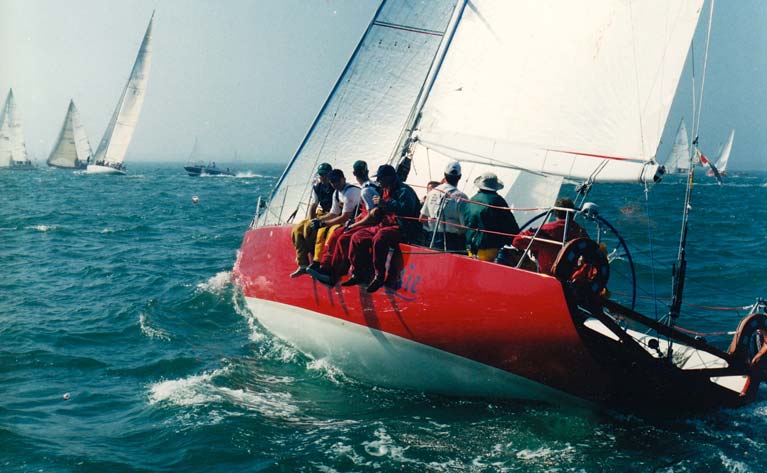 Cracklin’ Rosie with a mostly Howth-Sutton crew shortly after the start of the 1997 Fastnet Race: A boat, a skipper and a crew at the height of their powers, with regular success at home and abroad. Photo: W M Nixon
Cracklin’ Rosie with a mostly Howth-Sutton crew shortly after the start of the 1997 Fastnet Race: A boat, a skipper and a crew at the height of their powers, with regular success at home and abroad. Photo: W M Nixon
Most recently he has been best known for his stellar campaigns with the Corby 36 Rosie, but we have to remember that by the time the boats left Roy's ownership, they were hugely different from the plans presented by John Corby.
Each winter, the boats would be trailed back to a special spot beside Roy's house, and unless you were in constant attendance you'd no idea of just how much tweaking and surgery was taking place. He brought his brilliant engineer's brain to the challenges of boat performance enhancement, and many are the specialists who experienced that special thrill of anticipation when they got a Monday morning phone call from Roy which simply opened with the quiet announcement: "I've got an idea".
For they could be sure an utterly fascinating project would follow, and even if it involved hours of brutal hard work by volunteers – such as the shifting of the weight configuration in the keel-bulb on Cracklin Rosie – well, Roy was the kind of leader who inspired people to loyal service way over and above the call of duty and friendship.
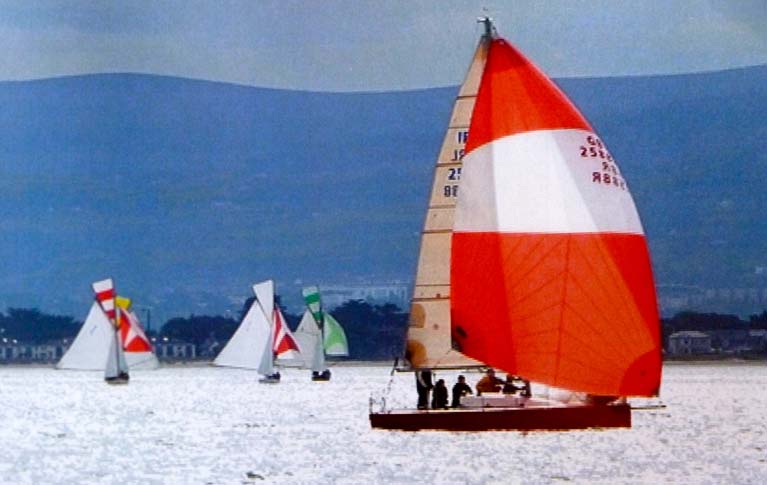 The home place…..the Corby 25 Rosie club racing at Howth with a trio of Howth 17s.
The home place…..the Corby 25 Rosie club racing at Howth with a trio of Howth 17s.
He was very highly regarded in the marine industry, and renowned sailmaker John McWilliam has been in touch from Australia to tell us that he felt lucky to have done business with Roy over many years, sailing with him and helping him modify the super boats he built – John says his aim was always to stay competitive, and he achieved this target with vision, skill, enthusiasm, kindness – and always a smile.
His generosity was boundless – when he was unable to go on a campaign with Rosie, he always ensured that his crew were encouraged to take the boat themselves, and they achieved many successes in the best Dickson style in events as various as the Scottish Series, Cork Week, and the British IRC Open
The passing of this remarkable sailor and boat-innovator makes us wonder if we’ll ever see his like again. Roy Dickson may have been at the forefront of many developments, but he was a very talented man operating in a pre-specialisation age. Nowadays, the sort of projects he successfully undertook between his workshop and the boat in the garden would be in the province of specialists in highly-equipped air-conditioned premises, yet Roy Dickson managed it all on a “make-it-up-as-you-go-along” basis.
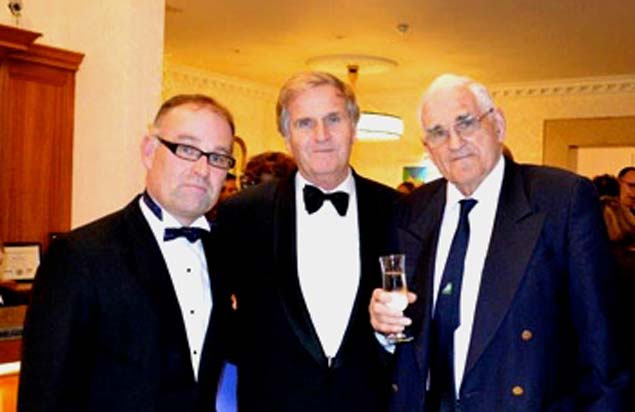 At the 75th Anniversary of Sutton Dinghy Club in 2014 were (left to right) Commodore Andy Johnstone, Olympic helm Barry O’Neill, and 1954 Commodore Roy Dickson
At the 75th Anniversary of Sutton Dinghy Club in 2014 were (left to right) Commodore Andy Johnstone, Olympic helm Barry O’Neill, and 1954 Commodore Roy Dickson
In fact, there’s no doubting he was a very special one-off. He needed personal projects, the more complex the better, and boats and sailing provided them in abundance and brought out his skills in communication – exceptional skills which everyday life didn’t always evoke. The world of sailing has been greatly enriched by his long time in it. And the loyalty and dedication of his numerous friends-as-shipmates – drawn from many places and backgrounds – is eloquent testimony to the effect he had on others when they shared his devotion and enthusiasm.
Our thoughts are with them and particularly with his four sons – David, Alan, Gary and Ian – and their families, in whom the Dickson sailing gene is frequently manifested. Particularly so in the case of Roy’s grandson and Ian’s son Robert Dickson, Ireland’s 2018 Sailor of the Year with Sean Waddilove for their Gold Medal in the International 49er U23 Worlds. It’s for sure that Roy Dickson was a sailing universe whose spirit lives on.
WMN
Roy Dickson 1932-2020
We regret to announce the death a the age of 87 of Roy Dickson of Howth and Sutton, a former Commodore of both Sutton DC and Kilbarrack SC, and a renowned dinghy racer and offshore sailor who was a pioneer of the International Fireball Class and went on to major offshore success in several boats of the calibre of Imp, Cracklin’ Rosie and Rosie.
Our thoughts are with his family and friends and shipmates at this time. A full appreciation is here.
Ireland’s Fireball Dinghy Class Provided The Secret Of Eternal Youth
You’ll have glimpsed the photo gallery and heard the reports of the International Fireball Dinghy Class 50th Anniversary Irish Reunion last Saturday night in the Royal St George YC in Dun Laoghaire. Fifty years, by George……Most sailing folk still think of the Fireball as a fresh and unique off-the-wall sailing phenomenon, a crazy European take on the skimming-dish scows of the lakes of America’s mid-West. And we think of these very special racing dinghies as being something as new as tomorrow, ingenious boats for ingenious owners who like to do all sorts of personal tunings and tweaks to their pride-and-joy. So it brings us up short to find them celebrating their Golden Jubilee. W M Nixon gives his own take on the Former Fireball Fanatics.
If you’re from anywhere well outside the bubble which is southeast Dublin, you’ll assume that a group of guys who regularly drink in a place called the Tramyard will be a bunch of winos. But those in the know are well aware that the Tramyard in Dalkey is a more-than-agreeable coffee house where a regular group of morning habituees supping the essence of the sacred bean is a gathering of sailing friends who have been mates since studying in college or whatever they were doing at that exciting time of life, when all things were possible, and just to have an idea was enough to have the energy to implement it and do something with the result.
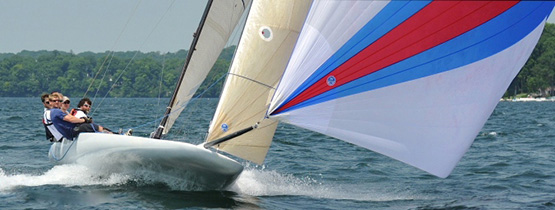
The inspiration for the Fireball design more than fifty years ago came partially from the classic scows of the lakes of mid-western America. This is a Melges Class A Scow.
As this Tramyard crowd have been regularly together for so long, they have not noticed the effects of the passing of the years on each other. So when Derek Jago got to reflecting among them last Autumn that maybe their best sailing years were spent in the Fireball Class, and that it was amazing to think it had been around for fifty years, former Fireball champion Brian Craig immediately suggested that if Derek would organise a post-50th Anniversary Reunion of the Irish Fireball Class past and present, then he – Brian - would see about making the Royal St George Yacht Club available as the venue, for after all it was the George – home club for most of them - which had the biggest Fireball fleet in the great days of the class’s Irish glory.
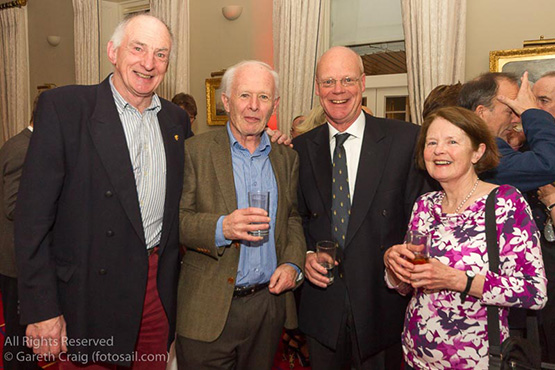
The party happens – Derek Jago (left) with former Fireballers Howard Knott, Peter Stapleton and Hilary Knott. Photo: Fotosail
Of course, when you do organise something like this, you will know what your own close circle of old friends now look like. But it’s a fascinating exercise in the observation of the aging process to wheel in people you mightn’t have seen in thirty and more years.
In fact, it might have been fraught with a certain risk of non-recognition of faces from the distant past. But the Irish Fireball Class was not only an outstanding success in its peak years, it went on to send out rising stars who were to make their mark in many other areas of sailing. Consequently last Saturday night proved to be a gathering of familiar faces of whom, in some cases, folk were saying: “But I never knew you were ever a Fireball sailor”.
Yet not only were they Fireball sailors once upon a time, but they were very proud of the fact. For in the nicest possible way, the Fireball was and is a bit of a cult thing. She was designed by Peter Milne, who at the time of her creation was working on the drawings for the latest Donald Campbell world water speed record challenger. In the midst of such a hothouse of technology and massive expenditure, it seemed like a breath of fresh air to take a little time out to create a boat which reduced sailing to its absolute essentials, and he did it so well that Peter Milne thereafter never quite matched this one divine inspiration.
And it was truly inspirational. After all, who would have thought that a minimalist boat, with just about zero freeboard and skinny with it, and with her slim hull further reduced in volume by having a cut-off pram bow, who could have thought it would be such a superb sailing machine when she’d a crew who gave total commitment to the concept and realized that the use of the trapeze was what Fireball sailing was all about?

The first in Ireland –Roy Dickson’s No 38 making a tentative visit to Dun Laoghaire in September 1962.
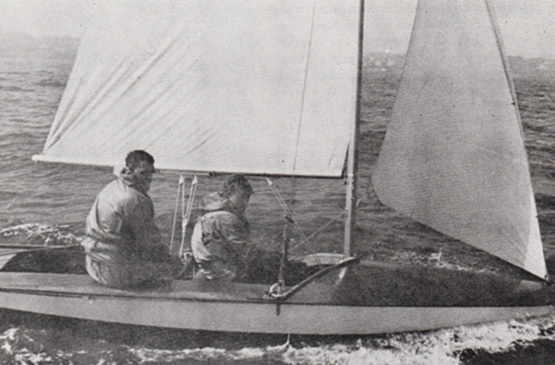
Champions – Roy Dickson crewed by David Lovegrove after successfully defending the Fireball Nationals in 1966.
Well, the first in Ireland was Roy Dickson of Kilbarrack and Sutton on the north shores of Dublin Bay, a man who cannot contemplate any boat without thinking about ways of improving it. He’d already been taking several sails on the wild side by building a Jack Holt-designed 16ft Hornet with a sliding seat in the manner of Uffa Fox’s famous sailing canoes, so when the design of the Fireball first appeared in Yachts & Yachting magazine in 1962, it was a eureka moment.
Roy’s first Fireball, no 38, made a tentative appearance across Dublin Bay in Dun Laoghaire at the end of the 1962 season, and next Spring it was revealed that other sailors from the north shore were following in his footsteps. They’d already set up a class association with Peter O’Brien as Chairman and Eddie Kay as Honorary Secretary, and it was expected that up to 20 Fireballs would be racing in Ireland by the end of the 1963 summer.
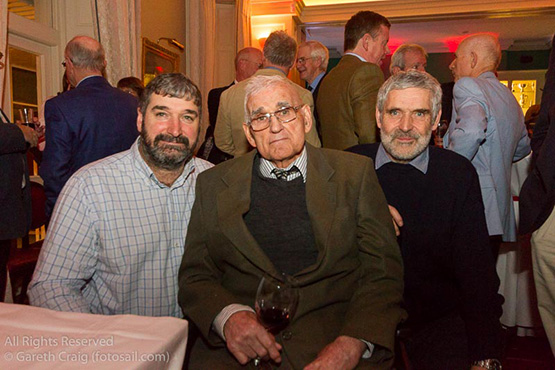
The founding father – Roy Dickson with his sons Ian (left) and David on Saturday night at the celebration of the Irish Fireball Class. Photo: Fotosail
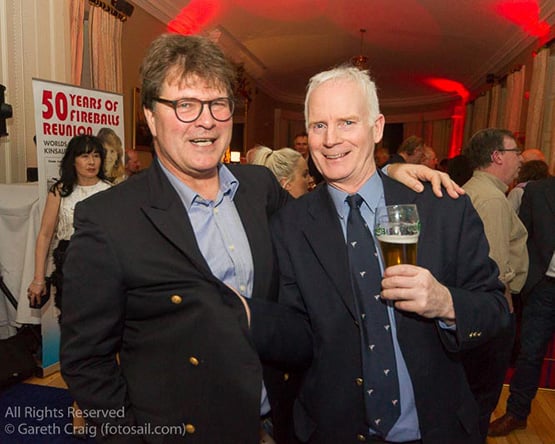
Jan van der Puil (left) with 1995 World Champion John Lavery. Photo: Fotosail

Early days – at an IYA Easter Meeting in Wexford the new Fireballs cut a dash by comparison with the older IDRA 14 and Enterprise in the background. Photo: W M Nixon
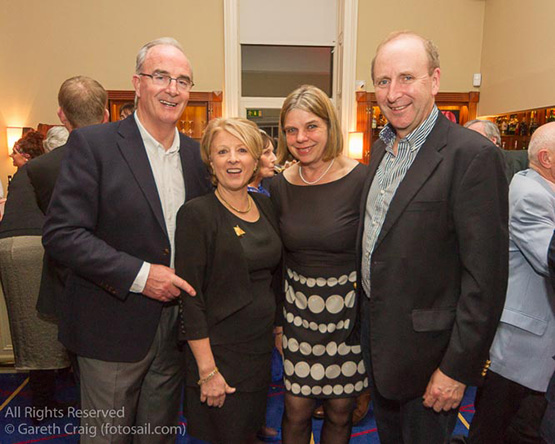
Celebrating the Fireball – Anthony and Sally O’Leary, with Cathy McAleavey and Con Murphy. Photo: Fotosail
It was an extraordinary breakthrough, the memory of it all made even more vibrant by the fact that Roy Dickson himself was there in Dun Laoghaire last Saturday night, his innovative Fireball years recalled as just another chapter in his own fantastic sailing career, which has gone right to the top both inshore and offshore.
The Fireball spoke eloquently to several successive waves of Irish sailors, and in the period between the mid 1960s and the late 1990s, you’d be hard put to say just what was the key year, with an early dose of extreme excitement being the Fireball Worlds at Fenit on Tralee Bay in 1970, John Caig from England being the winner. For although an unmatched high was reached in 1995 when John Lavery and David O’Brien of the National YC won both the Europeans and the Worlds in a mega regatta staged by their home club on Dublin Bay, at other times Adrian and Maeve Bell from the north – they were with Lough Neagh SC at the time - were very much in the international frame, counting many major titles.

Fireballs on an early outing to Sligo, where the Worlds were staged in 2011.
As for staging Fireball World Championships, Ireland has stepped up to the plate four times, with a particularly epic Worlds in Kinsale in 1977 where the Godkin brothers set the pace in the local fleet. Then there was the glorious home win at Dun Laoghaire in 1995. And the most recent Worlds in Ireland were at Sligo in 2011, where the great Gus Henry may have been best known as a stalwart of the GP 14 Class, but he too is a top sailor who savoured the Fireball experience.
At the height of the class’s popularity, nearly three quarters of the boats in Ireland were said to be an own-build, and Roy Dickson was the pace-setter in innovation. It’s said that if Roy turned up at a major international regatta with some completely new but barely perceptible additional feature on his boat, by the next championship you could be reasonably sure that at least half the fleet would have copied him.
But for some years now the class has seen plastic boats in the ascendant, which restrains the innovators. And numbers in Ireland are admittedly no longer so spectacular, for in its top years the truly active Fireball fleet here numbered 70 boats, which for an out-and-out performance dinghy was quite something.

There’s still as little bulk to the boat as possible, but they’re now built in GRP, as seen here with Frank Miller's boat at the Volvo Dun Laoghaire Regatta. Photo: VDLR
Yet while the fleets are reduced, the memories if anything are stronger than ever. The photos reveal the calibre of the people who were and are involved in Fireball racing in Ireland – it’s a national Who’s Who of sport afloat. And if that weren’t enough, the roll call of those who preceded John Lavery and David O’Brien in the intense battles to win the World Championship is of truly global stature in international sailing.
The first one of all in 1966 was Bob Fisher, no less, crewed by Richard Beales. Then Steve Benjamin of the US was in fine form in the 1970s, as he won in ’76 and then defended successfully at Kinsale in 1977. But in 1978 at Pattaya in Thailand, a new name came centre stage – the one and only Lawrie Smith. Then in 1981 the Worlds winner was future top dinghy designer Phil Morrison, with Fireball mods and tuning worthy of Roy Dickson.
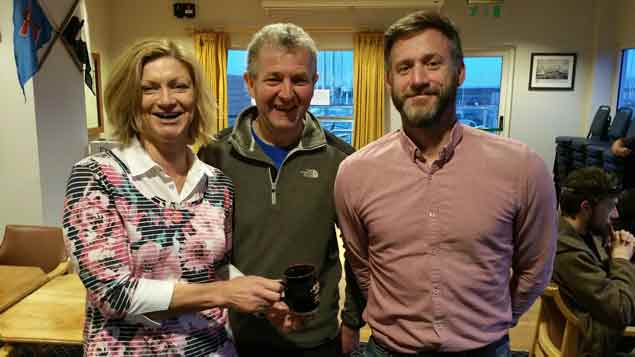
Current Irish Fireball Class Chairperson, seen speaking at last Saturday’s party, is Marie J Barry. Photo: Fotosail
In 1994 it was ace sailmaker and multi-champion Ian Pinnell who won the Fireball Worlds, and this set the bar high for John Lavery and David O’Brien in Dublin Bay in 1995. Faced with the challenge, they implemented a rigorous two-year training and competition programme in the countdown to the big one, and it all came out as planned.
As the Fireball Worlds 1995 were staged in September, the rest of the Irish sailing community were well home from holidays and back at the day job, so those driving home from work on the Friday night heard it on the car radio as one of the top stories on the evening sports news. Ireland had won a world title. Better still, it was in sailing too. And it was on the peaktime national news. It was a moment to be recalled and savoured many times in Dun Laoghaire last Saturday night.

We can always use a cover like this – welcome news with David O’Brien and John Lavery from the Sept/Oct 1995 Afloat.
See full Fireball 50th photo gallery by Gareth Craig of Fotosail here




























